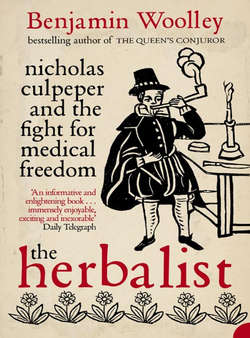Читать книгу The Herbalist: Nicholas Culpeper and the Fight for Medical Freedom - Benjamin Woolley - Страница 4
PREFACE
ОглавлениеIn the landscape of history, Nicholas Culpeper has not always been welcome. If monarchs, ministers, political notables and scientific luminaries are stately oaks or cultivated blooms, Culpeper is the Cleavers (or Goosegrass, or Barweed, or Hedgeheriff, or Hayruff, or Mutton Chops, or Robin-Run-in-the-Grass, to use any of its multitude of names), a common grass that is ‘so troublesome an Inhabitant in Gardens’, creeping into the herbaceous borders and snagging clothes. As a result, he has been weeded out of the historical record, and barely a trace of him is left. The only documentation relating to him that survives is a brief memoir, one letter, a couple of manuscript fragments, several tantalising mentions in official papers, and some pamphlets. His own voluminous writings brim with character, but are almost empty of biographical details. Official medical and botanical histories written while he lived and since have contributed nothing, and in some cases have taken a great deal away. For this reason, Nicholas’s presence in history, and in the account that follows, is necessarily fleeting.
However, hidden in the undergrowth is a startling story, entangled with so many others, with the struggles of the woodturner Nehemiah Wallington to survive the plague, with the mischievous prophesies of the astrologer William Lilly, with the Olympian struggles and self-belief of King Charles I, and most of all with the anatomical explorations and loyal ministrations of the King’s doctor William Harvey, the Isaac Newton of medical science and model of medical professionalism. Like the Cleavers and other discarded weeds championed in his Herbal, Nicholas certainly had ‘some Vices [but] also many Virtues’. His vices were well known, itemised by friends as well as his many enemies: smoking, drinking, ‘consumption of the purse’. But he was also audacious and adventurous. He championed the poor and sick at a time when they were more vulnerable than ever. He took on an establishment fighting for survival and ferociously intent on preserving its privileges.
The heirs of that same establishment are inevitably the custodians of much of the material upon which this book relies, in particular the Royal College of Physicians, which provided generous access to its archives. Acknowledgement must also go to the Society of Apothecaries, the British Library, the Bodleian Library at Oxford, the Cambridge University Library, the Records Offices of the counties of East and West Sussex, Kent, Surrey, and of London, primarily the Guildhall Library, the Corporation of London and the Metropolitan Archives. Individual thanks are due to Briony Thomas and the Revd Roger Dalling for local information on Nicholas’s childhood, to Dr Jonathan Wright for reading the manuscript and Dr Adrian Mathie for checking some of the medical information.
The dates given are new style unless otherwise stated. Spelling and punctuation have been modernised where appropriate. Notes at the back provide details on sources, clarifications and definitions of some of the medical and astrological terminology, and brief discussions of the historical evidence. One final note: the capitalised ‘City’ refers to the square mile that is the formally recognised city of London, a distinct political as well as urban entity with its own government and privileges, lying within the bounds of the ancient city walls. ‘London’ or the ‘city’ refers to the wider metropolitan area, embracing the city of Westminster to the west, Southwark on the south bank of the Thames, and the sprawling suburbs to the north and east.
